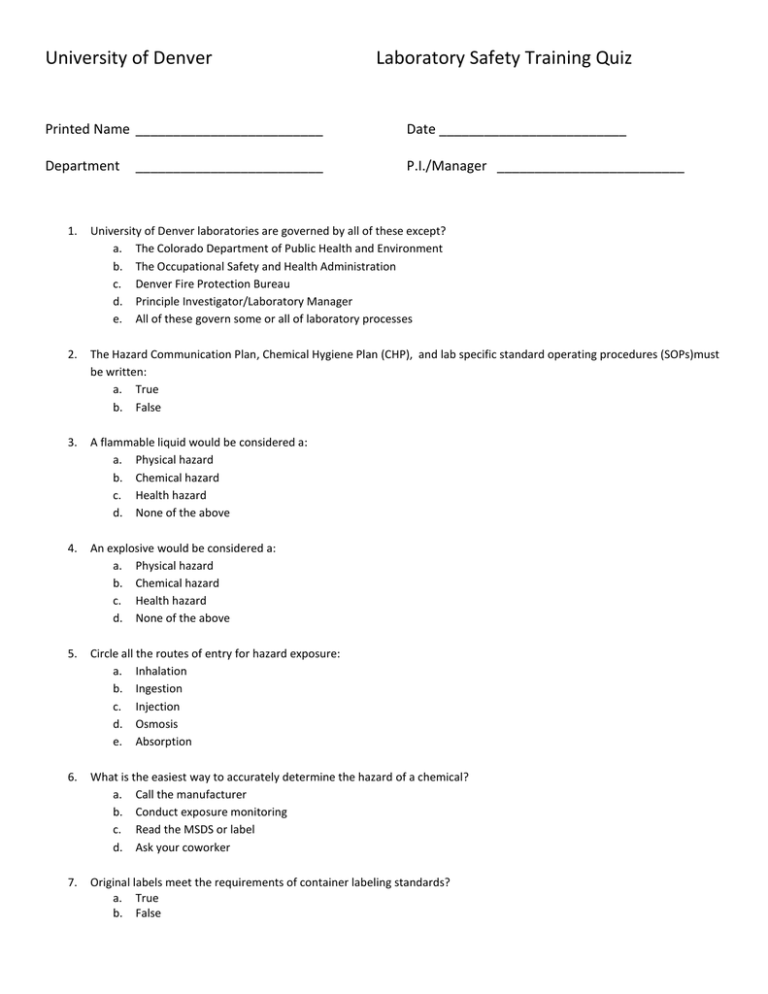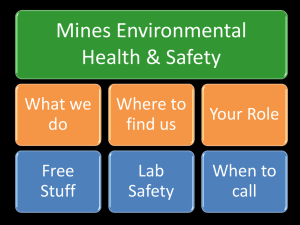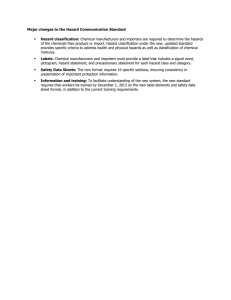Annual Laboratory Training Safety Quiz
advertisement

University of Denver Laboratory Safety Training Quiz Printed Name _________________________ Date _________________________ Department P.I./Manager _________________________ _________________________ 1. University of Denver laboratories are governed by all of these except? a. The Colorado Department of Public Health and Environment b. The Occupational Safety and Health Administration c. Denver Fire Protection Bureau d. Principle Investigator/Laboratory Manager e. All of these govern some or all of laboratory processes 2. The Hazard Communication Plan, Chemical Hygiene Plan (CHP), and lab specific standard operating procedures (SOPs)must be written: a. True b. False 3. A flammable liquid would be considered a: a. Physical hazard b. Chemical hazard c. Health hazard d. None of the above 4. An explosive would be considered a: a. Physical hazard b. Chemical hazard c. Health hazard d. None of the above 5. Circle all the routes of entry for hazard exposure: a. Inhalation b. Ingestion c. Injection d. Osmosis e. Absorption 6. What is the easiest way to accurately determine the hazard of a chemical? a. Call the manufacturer b. Conduct exposure monitoring c. Read the MSDS or label d. Ask your coworker 7. Original labels meet the requirements of container labeling standards? a. True b. False University of Denver Laboratory Safety Training Quiz 8. Containers containing unused, in-process chemicals should be labeled with at least the following: a. “Hazardous Waste”, concentration, full chemical name b. Full chemical name, concentration, hazard class c. Full chemical name, concentration, accumulation start date d. Name of P.I., full chemical name, volumes added, accumulation start date 9. Written documentation needed to identify and mitigate hazards is mandatory and can be found in: a. The Chemical Hygiene Plan (CHP) b. Lab specific standard operating procedures (SOPs) c. Both the CHP and SOPs d. The employee handbook 10. Lab-specific SOPs can be written for: a. Processes b. Hazards c. Either d. Neither 11. Lab specific SOPs should identify: a. Hazards associated with the process b. Where materials should be stored c. Personal protective equipment and engineering controls required for procedures d. Clean-up directions e. All of the above 12. EHS conducted personal exposure monitoring compares the measured levels of the chemical being monitored to: a. Effectiveness levels of PPE b. The OSHA permissible exposure limit (PEL) c. Average levels for similar processes in the industry d. Previous levels measure at the University 13. All the following are controls that can/should be implemented to reduce or eliminate exposure except for: a. Engineering controls b. Work practices – limiting exposure time c. Personal protective equipment d. Chemical substitution e. Buddy system 14. Lab personnel are required to complete a monthly check for all the following except: a. Safety shower b. Eyewash station c. Laboratory fire extinguisher d. Spill kits University of Denver Laboratory Safety Training Quiz 15. Lab personnel are required to complete safety training (EHS provided or lab specific): a. On initial hire b. Annually c. When working with new hazards d. Both on initial hire and annually e. All of the above 16. Safety glasses provide as much protection as goggles if they have side shields a. True b. False 17. Circle the four L’s referring to the EPA’s most cited violations are? a. Lids – closed containers b. Learning - training c. Limits – permissible exposure levels d. Labels – information required to be on chemical and chemical waste labels e. Leaks – secondary containment f. Location – waste containers at point of waste generation 18. You should only clean up a spill if a. The volume is manageable b. You have the proper clean-up equipment/material c. You have the proper PPE d. All of the above 19. Waste accumulation is limited: a. To 1 year from the accumulation start date b. To 1 container per waste stream c. To 1 container per waste stream per laboratory d. All of the above 20. All of the following should be on a waste container label with the exception of a. Accumulation start date b. Full chemical names of additives c. Volumes of additives d. The words “Hazardous Waste” e. All should be on the label Signature: __________________________ Date____________________ Please keep this with your CHP and send a copy to EHS through: Campus Mail to EHS, Mary Reed #418; Email to cshort8@du.edu; or Fax to 303-871-4455



